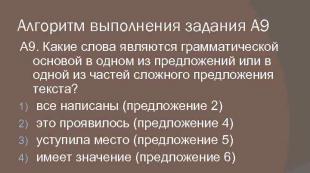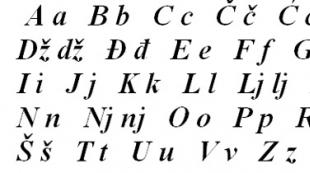Syntactic construction. Syntactic constructions in a work of fiction Complex syntactic construction examples from fiction
Lecture number 14
COMPLEX SYNTAX CONSTRUCTIONS
Plan
Link types in complex syntactic constructions
Punctuation marks in complex syntactic constructions
Parsing
Literature
1. Valgina N.S. The syntax of the modern Russian language: [Textbook. for universities on specials. "Journalism"] / NS Valgin. - M .: Higher school, 1991 .-- 431 p.
2. Beloshapkova V. A. Modern Russian language: Syntax / V.А. Beloshapkova, V.N. Belousov, E.A. Bryzgunov. - M .: Azbukovnik, 2002 .-- 295 p.
Complex syntactic constructions are combinations of parts with diverse syntactic link. These are combined types of sentences, they are diverse in terms of possible combinations of parts, however, with all their diversity, they lend themselves to a fairly clear classification.
The following types of complex syntactic constructions are possible depending on the various combinations of the types of links between the parts.
1. Complex sentences, which include complex sentences (complex sentences with composition and submission, complex sentences of mixed composition). The room we entered was separated by a barrier, and I did not see who I was talking to and to whom my mother was bowing humbly.(Kaverin). Incessantly, involuntarily, my gaze collided with this terribly straight line of the embankment and mentally wanted to push it away, to destroy it, like a black spot that sits on the nose under the eye; but the embankment with the walking Englishmen remained in place, and I involuntarily tried to find a point of view from which I would not see it(L. Tolstoy).
The sun went downandthe night followed the day without a gap,howit usually happens in the south(Lermontov).
That was the time when the poems of Polonsky, Maikov and Apukhtin were better known than simple Pushkin tunes, and Levitan did not even know that the words of this romance belonged to Pushkin.(Paust.).

There may be a compositional and subordinate unions nearby: The weather was beautiful all daybut,whenwe swam to Odessa, it started raining heavily.

2. Complex sentences with a non-allied and allied combination of parts, including complex sentences. I appreciate it and do not deny its significance; this world rests on people like him, and if the world were left to us alone, we, with all our kindness and good intentions, would make of him the same thing that flies out of this picture(Ch.). In everything that fills the room, there is something that has long become obsolete, a kind of dry decay, all things exude that strange smell that flowers give, dried by time to the point that when you touch them, they crumble into gray dust(Bitter).
If ever your heart is squeezed with fear for the little ones, cast away all fears, extinguish anxiety, be firmly sure: they are with me and, therefore, everything is in order(Pavlenko).
![]()
(if…), , , [ sure in what? ]: and .
3. In complex syntactic constructions, all kinds of communication are possible.
Complex syntactic constructions are multi-term complex sentences with different types of syntactic connections, for example, compositional and subordinate, compositional and non-union, etc. Such sentences are sometimes called mixed sentences.
Sentences with different types of syntactic connection usually consist of two (at least) logically and structurally distinguishable parts or several, among which there may in turn be complex sentences. However, as a rule, the main parts have the same type of connection (compositional or non-union).
For example, in the sentence Mechik did not look back and did not hear the chase, but he knew that they were chasing him, and when three shots rang out one after the other and a volley rang out, he thought that they were shooting at him, and he started even faster (Fad .) four parts:
a) Mechik did not look back and did not hear the chase;
b) but he knew that they were chasing him;
c) and when three shots rang out one after another and a volley rang out, it seemed to him that they were shooting at him;
d) and he started even faster.
All these parts are connected by a compositional relationship, but within the parts there is subordination (see parts b and c).
The syntactic unit of the text is the period. A classic example is Lermontov "When the yellowing cornfield is worried."
When the yellowing cornfield is worried
And the fresh forest rustles at the sound of the breeze,
And a raspberry plum is hiding in the garden
Under the shade of a sweet green leaf;
When sprinkled with fragrant dew,
On a rosy evening or a golden hour in the morning,
From under the bush I have a silvery lily of the valley
Nods his head affably;
When the icy key plays across the ravine
And, plunging the thought into some kind of vague dream,
Whispers to me a mysterious saga
About a peaceful land, from where he rushes, -
Then my soul is humbled by anxiety,
Then the wrinkles on the brow disperse, -
And I can comprehend happiness on earth,
And in heaven I see God.
The period is a complex syntactic and rhythmic-intonation formation. The main feature of its structure is the presence of two parts, usually unequal in volume (the first is much superior to the second), with different melody and rhythm. The first part is pronounced in a higher tone (with a strong increase towards the pause), at an accelerated tempo; as a rule, it is divided into rhythmic sections. The second part, after a pause, is pronounced with a sharp decrease in tone, the rhythm slows down. Rhythm is supported by the parallel structure of the components of the first part, repetition of prepositions, lexical repetitions.
In terms of syntactic structure, the period is diverse; it can be in the form of a joint venture (one of the types or a complex structure) or a widespread, complicated simple one, or a text consisting of a number of sentences. In other words, a period is not so much a syntactic structure as a rhythmic stylistic figure.
A complex syntactic construction is a sentence in which there are different types of syntactic links. They can combine:
- Essay and non-union connections: "Large snowflakes first slowly descended on the sidewalk, and then fell faster - the blizzard began."
- Unionless with subordinates: "In the evening the weather deteriorated sharply, no one wanted to go for a walk when I finished my business."
- Mixed type: "All the guests walked into the hall in silence, took their places, and only after that they began to talk in whispers until the one who invited them here appeared at the door."
- Compositional and submissive connections: "A large beautiful maple leaf fell at my feet, and I decided to pick it up to put it in a vase at home."
In order to correctly compose complex syntactic constructions, you should know how exactly their parts are related to each other. The placement of punctuation marks also depends on this.
Writing connection type
In Russian, a complex syntactic structure can consist of parts united by one of 3 types of connections - compositional, subordinate and non-union, or all at the same time. Syntactic structures with a compositional type of connection combine two or more equal sentences connected by a compositional union.
Between them one could put a point or swap them, since each of them is independent, but together in meaning they make up a single whole, for example:
- Read this book and you will discover a whole new vision of reality. (You can put a full stop between the two sentences, but the content will remain the same).
- A thunderstorm was approaching, and dark clouds appeared in the sky, and the air was filled with moisture, and the first gust of wind shook the crowns of the trees. (The parts can be swapped, but the meaning of the sentence remains the same).
A compositional connection can be one of the connecting components in complex sentences. There are known examples of its combination with non-union communication.
Combining with intonation
A complex syntactic construction often combines a compositional connection with a non-union one. This is the name for complex sentences, parts of which are connected exclusively by intonation, for example:
"The girl quickened her step (1): the train, puffing, drove up to the station (2), and the whistle of the locomotive confirmed this (3)."
There is a non-union connection between the 1st and 2nd parts of the construction, and the second and third sentences are united by a compositional connection, they are completely equal, and you can put a point between them.

In this example, there is a combination of compositional and non-union connections, united by a single lexical meaning.
Constructions with a compositional and subordinate link
Sentences in which one part is main and the other is dependent are called complex sentences. In this case, from the first to the second, you can always ask a question, regardless of where it is located, for example:
- I do not like (when what?) When they interrupt me. (The main part is at the beginning of the sentence).
- When they interrupt me, I don't like it (when?). (The proposal starts with a subordinate clause.)
- Natasha decided (for how long?) That she would leave for a long time (for what reason?), Because what happened greatly influenced her. (The first part of the sentence is dominant in relation to the second, while the second is in relation to the third).
Combined into a single whole, the compositional and subordinate connections form complex syntactic constructions. We will consider examples of sentences below.
"I realized (1) that new trials awaited me (2), and this realization gave me strength (3)."
The first part is the main one in relation to the second, since they are connected by a subordinate link. The third is attached to them by a compositional connection with the help of the union and.

"The boy was about to cry (1) and tears were already filling his eyes (2) when the door opened (3) so he could follow his mother (4)."
The first and second sentences are connected by a compositional connection with the help of the conjunction "and". The second, third and fourth parts of the construction are linked by subordination.
In complex syntactic constructions, the sentences of which they are composed can be complicated. Let's look at an example.
"The wind rose, intensifying with each gust (1), and people hid their faces in their collars (2) when a new flurry overtook them (3)."
The first part is complicated by the adverbial turnover.
Types of non-union and subordinate constructions
In the Russian language, you can often find non-union sentences combined with a subordinate type of communication. In such constructions, there can be 3 or more parts, some of which are main for some and dependent for others. They are joined by parts without conjunctions using intonation. This is the so-called complex syntactic construction (examples below) with a subordinate-unified connection:
"In moments of particular fatigue, I had a strange feeling (1) - I am doing something (2), to which my soul does not lie at all (3)."
In this example, the 1st and 2nd parts are connected with each other by the general meaning and intonation, while the 2nd (main) and 3rd (dependent) are a complex sentence.

"When it snowed outside (1), my mother wrapped me in numerous scarves (2), because of this I could not move normally (3), which was extremely difficult to play snowballs with other guys (4)."
In this sentence, the 2nd part is the main in relation to the 1st, but at the same time it is associated with the 3rd intonation. In turn, the third sentence is the main one in relation to the fourth and is a complex structure.
In one complex syntactic structure, some parts can be connected without a union, but at the same time be part of a complex sentence.
Design with all types of communication
A complex syntactic construction in which all types of communication are used simultaneously is not common. Similar sentences are used in literary texts when the author wants to convey events and actions as accurately as possible in one phrase, for example:
"The whole sea was covered with waves (1), which became larger when approaching the shore (2), they crashed with a noise on a solid barrier (3), and with a disgruntled hiss, the water retreated (4) to return and strike with renewed vigor ( 5)".

In this example, the 1st and 2nd parts are connected by a subordinate link. The second and third are non-union, between the third and the fourth there is a compositional connection, and the fourth and fifth are again subordinate. Such complicated syntactic constructions can be divided into several sentences, but as a whole, they carry an additional emotional coloring.
Separation of sentences with different types of communication
Punctuation marks in complex syntactic constructions are placed on the same basis as in complex, compound and non-union sentences, for example:
- As the sky in the east turned gray, the crowing of a rooster was heard. (subordinate relationship).
- A light haze lay in the valley, and the air trembled over the grasses. (compound sentence).
- When the disk of the sun rose above the horizon, it was as if the whole world was filled with sounds - birds, insects and animals welcomed the new day. (A comma stands between the main and dependent parts of a complex sentence, and a dash separates it from a non-union).

If you combine these sentences into one, you get a complex syntactic structure (class 9, syntax):
"When the sky in the east began to turn gray, the crowing of a rooster was heard (1), a light haze lay in the valley, and the air trembled over the grasses (2), when the disk of the sun rose above the horizon, as if the whole world was filled with sounds - birds, insects and animals welcomed a new day (3) ".
Parsing complex syntactic structures
To parse a proposal with different types of communication, you must:
- determine its type - declarative, imperative or interrogative;
- find out how many simple sentences it consists of, and find their boundaries;
- determine the types of connections between parts of the syntactic structure;
- describe each block by structure (complex or simple sentence);
- draw up a diagram of it.
So you can disassemble a structure with any number of links and blocks.
Applying sentences with different types of links
Similar constructions are used in colloquial speech, as well as in journalism and fiction. They convey to a greater extent the feelings and emotions of the author than written separately. A great master who used complex syntactic constructions was Lev Nikolaevich Tolstoy.
Syntax - a section of linguistics that studies the structure of sentences and phrases.
Syntagmatic relations between words (or groups of words);
Structure, generation and perception of sentences;
Syntactic units;
Consideration of the types of syntactic links.
The syntax is - it is any combination of words or groups of words that have a direct connection.
Connection - realized valence. Valence is the ability of a linguistic unit to combine with units of the same level. Valence is most often not fully realized.
Syntactic units
Taxonomic- separate word forms in the sentence ( He left for the city - 4 taxonomic units).
Functional- taxonomic units or groups of taxonomic units that perform a certain function in a sentence.
Syntactic links
Non-directional communication - equal communication (or mutual subordination);
Directional communication - subordination (one unit is main, the second is dependent).
The concept of a syntactic function is difficult to define. We can say that the syntactic function is the relation of the unit to the sentence in which it is included. For example, in the sentence Birds fly word birds refers to the sentence as a subject (within the framework of certain concepts and terms), and the word fly- as a predicate. To clarify some syntactic functions, a construction framework of a smaller volume than a sentence is sufficient, cf. big bird where the syntactic function of the word big- definition to name bird- is clear within the framework of the given construction, that is, outside the sentence.
The existing theories of the syntactic structure of a sentence differ mainly in what syntactic units they operate and what connections they establish between these units.
SENTENCE- the basic unit of syntax designed to perform a communicative function - the function of a message. The main features of P., distinguishing it from others. Syntax. units - words (word forms) and phrases, are predicative, intonational formatting and grammatical organization.
Predicativeness called the grammatical complex. meanings that correlate P. with the act of speech, its participants and denoted by reality by placing it in a certain temporal and modal plane. Thus, the content of P., on the one hand, correlates with the moment of speech and is interpreted as referring to the present, past or future (or as having no specific temporal localization), and on the other hand, either as real - corresponding to reality, or as unreal - desired, possible, anticipated. The expression of predicativeness is based primarily on the personal forms of the verb, which themselves have predicative morphological. categories of tense and mood, but it can be determined by the very meaning of syntactic. P.'s models in combination with intonation suitable for this situation.
In syntax. P.'s structure can be divided into two main aspects: constructive and communicative. The constructive aspect is associated with the study of words and phrases with t. Sp. syntax connections and relations between them, its division into members of the sentence and the allocation of Ch. members that make up the basis of P.'s structure - its predicative core, as well as other aspects of grammatical. organization. As for the communicative aspect of P., it includes those content and structural properties of P., thanks to which it acquires the ability to express a certain purposeful "speech action" - a message, question, urge, etc. In this case, the first plan are such parameters of P. as the presence of a certain actual division, word order and intonation (and, accordingly, the choice of the most suitable linear-intonational structure of P. in its construction). Sometimes to distinguish between these two aspects of P., oppositions of P. and statements are used.
Tree - a graphic representation of the structure of a syntactic structure, the elements of which are points (nodes) connected by lines or arrows (branches) reflecting syntactic links. Top of the tree - uh the node from which the arrows only leave, but which they do not enter.
Traditional grammar
The functional units are the members of the proposal. Undirected and directional connections.
The subject is what the sentence says.
Concordance is a kind of grammatical connection where the dependent word acquires the same grammatical meanings that the main word has.
Management - the dependent word acquires certain grammatical meanings that the main word does not have, but which the main word requires.
Adjacency - the connection is expressed by the order of words and intonations.
Dependency grammar
Formal representation of the sentence structure in the form of a hierarchy of components, between which a dependency relationship is established.
Taxonomic units; links are only subordinate; top - predicate verb or its significant part; service words for nouns ...
Teniere grammar
L. Tenier "Fundamentals of Structural Syntax". M., Progress, 1988.
Functional units; links are only subordinate; the top is a verb, all other units obey it directly or indirectly. Directly subordinate units are divided into actants and sirconstants.
Actants - functional units that replace the obligatory valencies of the predicate verb in a non-elliptic sentence.
Sir constants - functional units, the presence of which reflects the optional valencies of the predicate verb (usually a circumstance).
The boundaries are fuzzy. The subject, the subject of the action, is traditionally considered the first actant.
The grammar of the constituent parts
L. Bloomfield, C. Hockett, Z. Harris.
The grammar of the neural network is a formal representation of the sentence structure in the form of a hierarchy of nested linearly disjoint elements that are maximally independent of each other.
NS is usually 2. Each is further segmented by 2. This procedure should be repeated until morpheme.
Any complex unit consists of two more simple and non-overlapping units called her directly constituents.
Units - NS; undirected communications; NS are characterized in terms of grammatical classes (noun, verb, auxiliary verb, prepositions, etc.).
Peculiarities:
- elements - sequences of word forms with different complexity;
Maintains both syntactic and linear structure;
Complex syntactic constructions 1) Compound sentences, which include compound sentences (compound sentences with composition and submission, compound sentences of mixed composition). The room we entered was separated by a barrier, and I did not see who I was talking to and to whom my mother was bowing humbly.(Kaverin). Incessantly, involuntarily, my gaze collided with this terribly straight line of the embankment and mentally wanted to push it away, to destroy it, like a black spot that sits on the nose under the eye; but the embankment with the walking Englishmen remained in place, and I involuntarily tried to find a point of view from which I would not see it(L. Tolstoy). 2) Complex sentences with a non-allied and allied combination of parts, including complex sentences. I appreciate it and do not deny its significance; this world rests on people like him, and if the world were left to us alone, we, with all our kindness and good intentions, would make of him the same thing that flies out of this picture(Chekhov). In everything that fills the room, there is something that has long become obsolete, a kind of dry decay, all things exude that strange smell that flowers give, dried by time to the point that when you touch them, they crumble into gray dust(Bitter). If ever your heart is squeezed with fear for the little ones, cast away all fears, extinguish anxiety, be firmly sure: they are with me and, therefore, everything is in order(Pavlenko). 3) A polynomial complex sentence. You could hear how skids creaked on the street, how coal trucks drove to the factory, and how half-frozen people shouted hoarsely at the horses.(Mamin-Sibiryak). If Nekhlyudov would then clearly realize his love for Katyusha, and especially if then they began to convince him that he could not and should not unite his fate with such a girl, then it would very easily happen that he, with his straightforwardness in everything, would decide that there is no reason not to marry a girl, whoever she is, if only he loves her(L. Tolstoy). cm. also subordination of sentences (in the article subordination).
Dictionary-reference book of linguistic terms. Ed. 2nd. - M .: Education. D. E. Rosental, M. A. Telenkova. 1976 .
See what "complex syntactic constructions" are in other dictionaries:
Grammatical (morpho-syntactic) features of the legislative style (language)- an integral part of the legislative style, the subject of which is the structure of words, forms of inflection, ways of expressing grammatical meanings, as well as a phrase and a sentence. Of particular importance is the section of linguistics, ... ... Elementary principles of the general theory of law
A complex sentence is a sentence that has two or more grammatical stems. There are 4 types of complex sentences: a complex sentence, a complex sentence, a complex sentence with different types of communication and a non-union complex ... ... Wikipedia
CLARITY OF SPEECH- CLARITY OF SPEECH. The characteristic of speech, established on the basis of its correlation with the possibilities of perception. Ya r. is one of the communicative qualities of speech. Speech is called clear if it is perceived by the addressee without difficulty. In the field of vocabulary ... New Dictionary of Methodological Terms and Concepts (Theory and Practice of Language Teaching)
See complex syntax ... Dictionary of linguistic terms
Vertograd multicolored is a monument of Old Russian literature of the second half of the 17th century. It was written by Simeon of Polotsk. Includes several thousand poetic texts written in syllabic verse. Is one of the most ... ... Wikipedia
Indonesian- (Bahasa Indonesia) one of the Austronesian languages (Malay-Polynesian branch, western sub-branch). According to the traditional classification, I. i. attributed to the Indonesian languages. The official language (since 1945) and the language of interethnic communication of the Republic ... ...
Malaysian language- Malaysian is the name of the official language of the Federation of Malaysia, used since 1969 along with the name Malay. Distributed on the Malacca Peninsula and adjacent islands, in North Kalimantan. The number of speakers is 9.3 million people ... ... Linguistic Encyclopedic Dictionary
TABLE OF CONTENTS- SPELLING I. Spelling of vowels in the root § 1. Checked unstressed vowels § 2. Unchecked unstressed vowels § 3. Alternating vowels § 4. Vowels after sibilants § 5. Vowels after c § 6. Letters e e § 7. Letter i II. Spelling of consonants ... ...
STYLISM- @ Select word XXXV. Choice of words § 139. Semantic and stylistic selection of lexical means § 140. Elimination of clericalisms and stamps § 141. Pleonasms and tautologies § 142. Eloquence of speech § 143 ... Spelling and Styling Reference
Syntax stylistic resources, or syntactic stylistics- - stylistic possibilities of syntax means, their role in generating stylistically marked statements; the ability of syntactic units to act as expressive stylistic means, i.e. associated with the achievement of ... ... Stylistic Encyclopedic Dictionary of the Russian Language
Books
- Russian language 9 cl R t h 1
- Russian language 9th grade Rt h 2, Bogdanova G. The manual is intended for the organization of repetition, consolidation and testing of knowledge of the Russian language. When composing the notebook material, the author proceeded primarily from the requirements of the basic level ...









